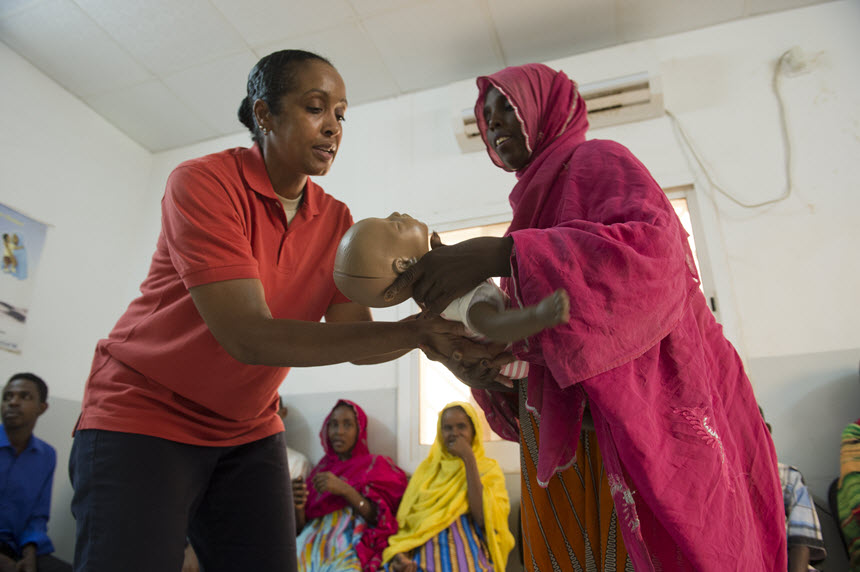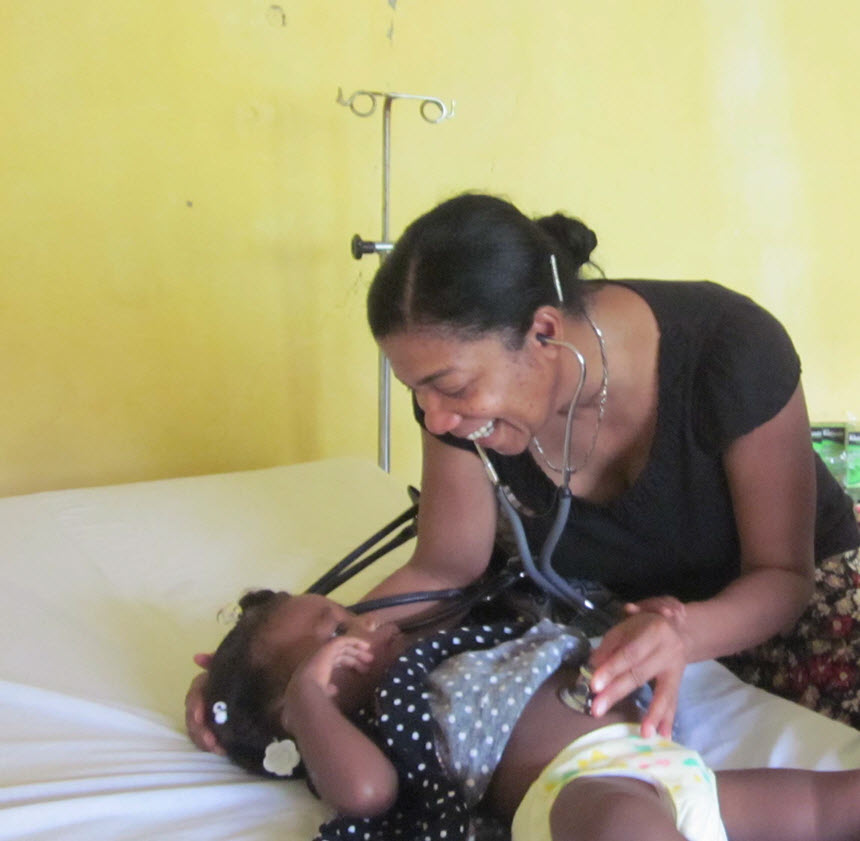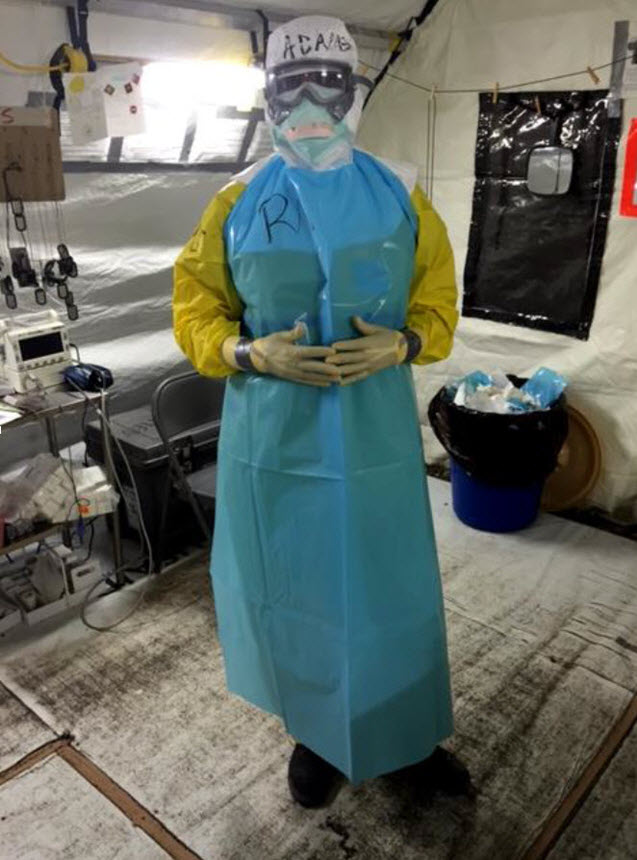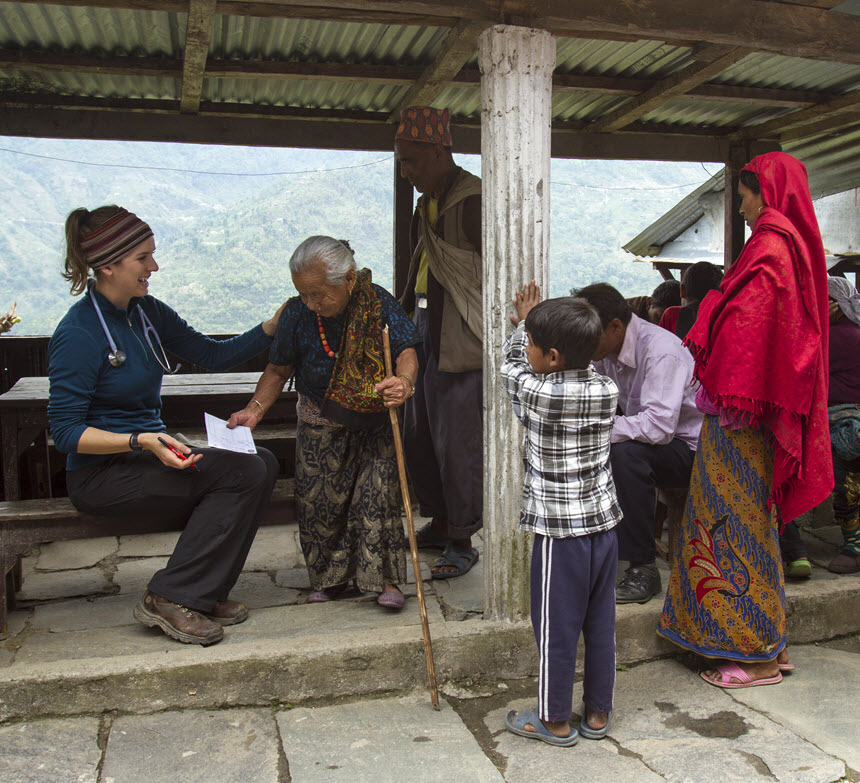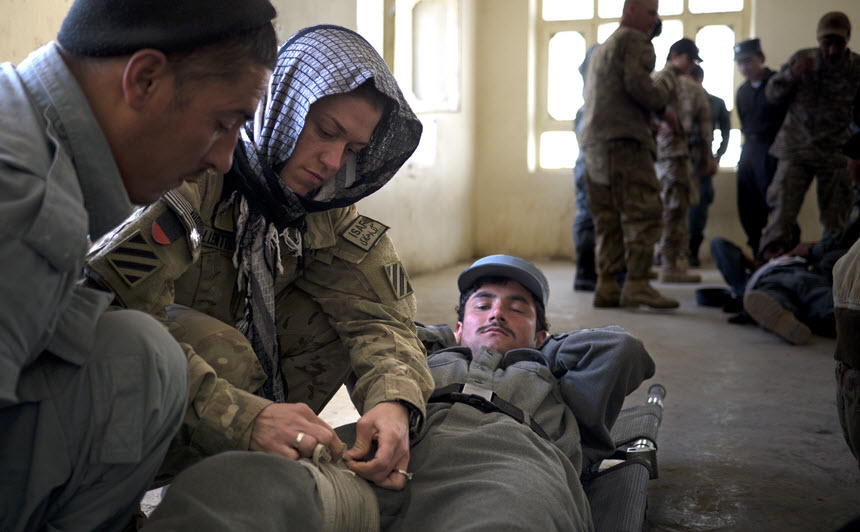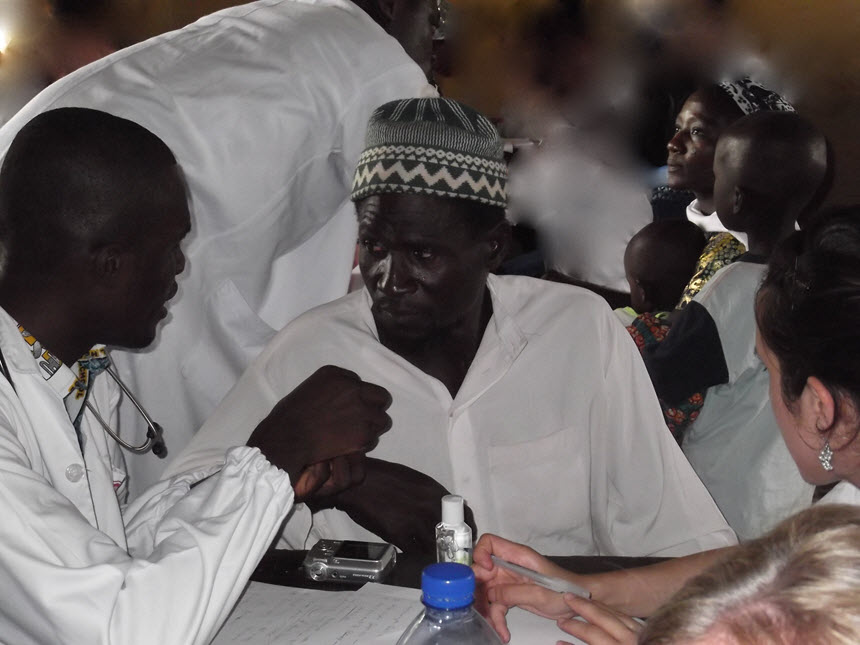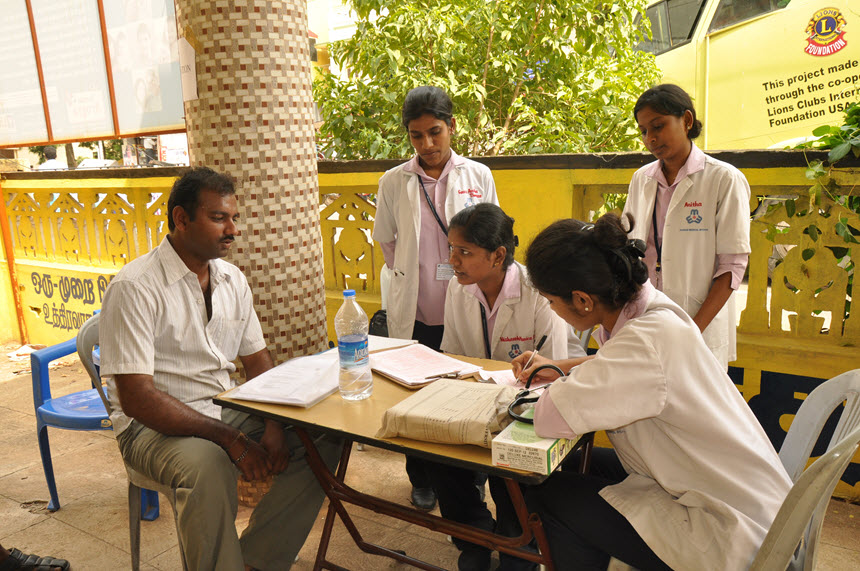Although the profession began as uniquely American, PAs’ proven success and their work abroad have influenced the global community. American PAs support efforts to expand the field internationally by teaching important medical skills and by aiding programs abroad. Other countries, such as Canada, the United Kingdom, the Netherlands, Ghana, and India have begun PA programs and are educating the next generation of health professionals.
PAs work and volunteer abroad to serve people globally. They provide essential medical aid and training to countries in times of need, such as during epidemics and natural disasters like earthquakes and hurricanes. Every day, through collaboration and care, PAs make a difference in people’s lives.
Samia Mohamed Douhour learns the Heimlich maneuver from U.S. Air Force Lt Col Leslie Randolph-Moss, PA-C during a community class at the Grand Douda Health Clinic, Djibouti, 2014
Courtesy U.S. Air Force photo by Staff Sgt. Leslie Keopka
Through community health classes, PAs teach people basic practices to prevent diseases and respond to medical emergencies. Classes cover many topics, such as hand washing, healthy eating, and the signs and symptoms of common local diseases like tuberculosis, malaria, and pneumonia. While teaching, PAs learn about local cultures, which improves their understanding of people’s lives and their interactions with patients.
Dominique Entzminger, PA-C examines a patient while serving as a volunteer medical responder in rural Haiti after Hurricane Sandy, Les Anglais, Haiti, 2013
Courtesy Anastasie Aubourg Foundation
Capt Robin Hunter-Buskey, PA-C wears protective gear while serving in Liberia during the Ebola crisis, Monrovia, Liberia, 2015
Courtesy Physician Assistant History Society
The Commissioned Corps of the U.S. Public Health Service sent PAs to Liberia during the rise of the Ebola epidemic of 2015. Hunter-Buskey worked with other health care professionals, such as Liberian PAs, to respond to the crisis.
During a University of Utah medical mission, PA students examine patients in Kimchee Health Camp in a remote Nepalese village, Ghandruk, Nepal, 2014
© Nick Pedersen, Courtesy University of Utah Physician Assistant Program
Some PA studies programs send students abroad for a combination of study and service. During these trips, students learn about how culture can impact illness and treatment, while aiding some of the most underserved people of the world.
U.S. Army Capt Nicole Ballentine, PA-C teaches Afghan policemen how to treat a leg injury during a class, Qalat, Afghanistan, 2013
Courtesy U.S. Army, photo by Spc. Tim Morgan
Ghanaian PAs and PA students (left) from Kintampo Rural Health Training School (KRHTS) work with PA students from University of Utah to perform community outreach in Kurawura-kuraa, Ghana, 2012
Courtesy Nadia Cobb
Kintampo Rural Health Training School is one of the growing number of PA programs in Ghana. The school teaches students with previous health care experience to practice in primary care and community outreach programs.
Indian PA students from the Medical Mission of Madras Program (right) perform community outreach with a patient (left) in Tamil Nadu, India, 2015
Courtesy Nadia Cobb
Samia Mohamed Douhour learns the Heimlich maneuver from U.S. Air Force Lt Col Leslie Randolph-Moss, PA-C during a community class at the Grand Douda Health Clinic, Djibouti, 2014
Courtesy U.S. Air Force photo by Staff Sgt. Leslie Keopka
Through community health classes, PAs teach people basic practices to prevent diseases and respond to medical emergencies. Classes cover many topics, such as hand washing, healthy eating, and the signs and symptoms of common local diseases like tuberculosis, malaria, and pneumonia. While teaching, PAs learn about local cultures, which improves their understanding of people’s lives and their interactions with patients.
Dominique Entzminger, PA-C examines a patient while serving as a volunteer medical responder in rural Haiti after Hurricane Sandy, Les Anglais, Haiti, 2013
Courtesy Anastasie Aubourg Foundation
Capt Robin Hunter-Buskey, PA-C wears protective gear while serving in Liberia during the Ebola crisis, Monrovia, Liberia, 2015
Courtesy Physician Assistant History Society
The Commissioned Corps of the U.S. Public Health Service sent PAs to Liberia during the rise of the Ebola epidemic of 2015. Hunter-Buskey worked with other health care professionals, such as Liberian PAs, to respond to the crisis.
During a University of Utah medical mission, PA students examine patients in Kimchee Health Camp in a remote Nepalese village, Ghandruk, Nepal, 2014
© Nick Pedersen, Courtesy University of Utah Physician Assistant Program
Some PA studies programs send students abroad for a combination of study and service. During these trips, students learn about how culture can impact illness and treatment, while aiding some of the most underserved people of the world.
U.S. Army Capt Nicole Ballentine, PA-C teaches Afghan policemen how to treat a leg injury during a class, Qalat, Afghanistan, 2013
Courtesy U.S. Army, photo by Spc. Tim Morgan
Ghanaian PAs and PA students (left) from Kintampo Rural Health Training School (KRHTS) work with PA students from University of Utah to perform community outreach in Kurawura-kuraa, Ghana, 2012
Courtesy Nadia Cobb
Kintampo Rural Health Training School is one of the growing number of PA programs in Ghana. The school teaches students with previous health care experience to practice in primary care and community outreach programs.
Indian PA students from the Medical Mission of Madras Program (right) perform community outreach with a patient (left) in Tamil Nadu, India, 2015
Courtesy Nadia Cobb
Although the profession began as uniquely American, PAs’ proven success and their work abroad have influenced the global community. American PAs support efforts to expand the field internationally by teaching important medical skills and by aiding programs abroad. Other countries, such as Canada, the United Kingdom, the Netherlands, Ghana, and India have begun PA programs and are educating the next generation of health professionals.
PAs work and volunteer abroad to serve people globally. They provide essential medical aid and training to countries in times of need, such as during epidemics and natural disasters like earthquakes and hurricanes. Every day, through collaboration and care, PAs make a difference in people’s lives.









